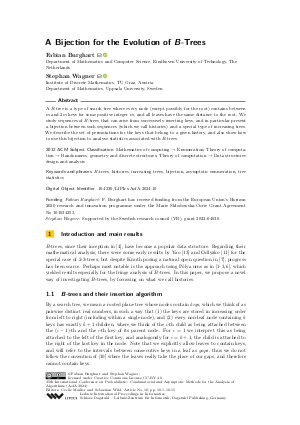A Bijection for the Evolution of B-Trees
Authors
Fabian Burghart  ,
Stephan Wagner
,
Stephan Wagner 
-
Part of:
Volume:
35th International Conference on Probabilistic, Combinatorial and Asymptotic Methods for the Analysis of Algorithms (AofA 2024)
Part of: Series: Leibniz International Proceedings in Informatics (LIPIcs)
Part of: Conference: International Conference on Probabilistic, Combinatorial and Asymptotic Methods for the Analysis of Algorithms (AofA) - License:
 Creative Commons Attribution 4.0 International license
Creative Commons Attribution 4.0 International license
- Publication Date: 2024-07-18
File

PDF
LIPIcs.AofA.2024.10.pdf
- Filesize: 0.8 MB
- 15 pages
Document Identifiers
Subject Classification
ACM Subject Classification
- Mathematics of computing → Enumeration
- Theory of computation → Randomness, geometry and discrete structures
- Theory of computation → Data structures design and analysis
Keywords
- B-trees
- histories
- increasing trees
- bijection
- asymptotic enumeration
- tree statistics
Metrics
- Access Statistics
-
Total Accesses (updated on a weekly basis)
0PDF Downloads0Metadata Views
Abstract
A B-tree is a type of search tree where every node (except possibly for the root) contains between m and 2m keys for some positive integer m, and all leaves have the same distance to the root. We study sequences of B-trees that can arise from successively inserting keys, and in particular present a bijection between such sequences (which we call histories) and a special type of increasing trees. We describe the set of permutations for the keys that belong to a given history, and also show how to use this bijection to analyse statistics associated with B-trees.
Cite As Get BibTex
Fabian Burghart and Stephan Wagner. A Bijection for the Evolution of B-Trees. In 35th International Conference on Probabilistic, Combinatorial and Asymptotic Methods for the Analysis of Algorithms (AofA 2024). Leibniz International Proceedings in Informatics (LIPIcs), Volume 302, pp. 10:1-10:15, Schloss Dagstuhl – Leibniz-Zentrum für Informatik (2024)
https://doi.org/10.4230/LIPIcs.AofA.2024.10
BibTex
@InProceedings{burghart_et_al:LIPIcs.AofA.2024.10,
author = {Burghart, Fabian and Wagner, Stephan},
title = {{A Bijection for the Evolution of B-Trees}},
booktitle = {35th International Conference on Probabilistic, Combinatorial and Asymptotic Methods for the Analysis of Algorithms (AofA 2024)},
pages = {10:1--10:15},
series = {Leibniz International Proceedings in Informatics (LIPIcs)},
ISBN = {978-3-95977-329-4},
ISSN = {1868-8969},
year = {2024},
volume = {302},
editor = {Mailler, C\'{e}cile and Wild, Sebastian},
publisher = {Schloss Dagstuhl -- Leibniz-Zentrum f{\"u}r Informatik},
address = {Dagstuhl, Germany},
URL = {https://drops.dagstuhl.de/entities/document/10.4230/LIPIcs.AofA.2024.10},
URN = {urn:nbn:de:0030-drops-204451},
doi = {10.4230/LIPIcs.AofA.2024.10},
annote = {Keywords: B-trees, histories, increasing trees, bijection, asymptotic enumeration, tree statistics}
}
Author Details
- Department of Mathematics and Computer Science, Eindhoven University of Technology, The Netherlands
Funding
- Burghart, Fabian: F. Burghart has received funding from the European Union’s Horizon 2020 research and innovation programme under the Marie Skłodowska-Curie Grant Agreement No 101034253.
- Wagner, Stephan: Supported by the Swedish research council (VR), grant 2022-04030.
References
-
D. Aldous, B. Flannery, and J.L. Palacios. Two applications of urn processes. Probability in the Engineering and Informational Sciences, 2(3):293-307, 1988.

- Ricardo A. Baeza-Yates. Fringe analysis revisited. ACM Comput. Surv., 27(1):111-119, 1995. URL: https://doi.org/10.1145/214037.214103.
-
A. Bagchi and A.K. Pal. Asymptotic normality in the generalized Pólya-Eggenberger urn model, with an application to computer data structures. SIAM Journal on Algebraic Discrete Methods, 6(3):394-405, 1985.

-
R. Bayer and E. McCreight. Organization and maintenance of large ordered indexes. Acta Informatica, 1:173-189, 1972.

- Olivier Bodini, Matthieu Dien, Xavier Fontaine, Antoine Genitrini, and Hsien-Kuei Hwang. Increasing diamonds. In LATIN 2016: theoretical informatics, volume 9644 of Lecture Notes in Comput. Sci., pages 207-219. Springer, Berlin, 2016. URL: https://doi.org/10.1007/978-3-662-49529-2_16.
-
B. Chauvin, D. Gardy, N. Pouyanne, and D.-H. Ton-That. B-urns. ALEA. Latin American Journal of Probability & Mathematical Statistics, 13:605-634, 2016.

-
V. Chvátal, D.A. Klarner, and D.E. Knuth. Selected combinatorial research problems. Computer Science Department, Stanford University, STAN-CS-72-292, 1972.

- Michael Drmota. Random trees. SpringerWienNewYork, Vienna, 2009. URL: https://doi.org/10.1007/978-3-211-75357-6.
-
Philippe Flajolet and Robert Sedgewick. Analytic Combinatorics. Cambridge University Press, 2009.

-
D.E. Knuth. The Art of Computer Programming: Volume 3. Sorting and Searching. Addison-Wesley, 2nd edition, 1998.

-
A.M. Odlyzko. Periodic oscillations of coefficients of power series that satisfy functional equations. Advances in Mathematics, 44:180-205, 1982.

- OEIS Foundation Inc. The On-Line Encyclopedia of Integer Sequences, 2024. Published electronically at URL: https://oeis.org.
-
A.C.C. Yao. On random 2-3 trees. Acta informatica, 9(2):159-170, 1978.

